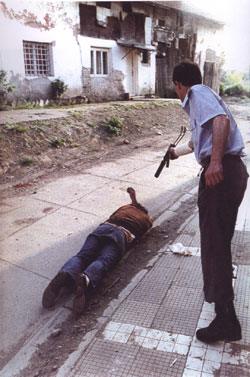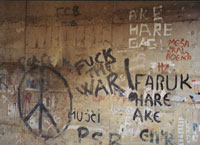Serb Soldiers Resist; Thugs Enlisted
[Excerpted from Chapter 8: War and Attempts at Peace]
While the world’s eyes were on Dubrovnik, the Yugoslav Army laid siege to
another lovely old Yugoslav city for three months. Vukovar was reduced to
rubble, while Dubrovnik was mostly preserved. What happened after the siege
ended – a massacre of 264 people captured from the local hospital --
generated additional charges against Milošević. The prosecution related the
events through a hospital director, two survivors, a JNA officer, and a
Serbian journalist. Their testimony disclosed one of the ugliest chapters of
the Croatian war.
C-57, a JNA officer who served in Vukovar, described the poor state of
JNA forces, prompting the use of paramilitaries. He told of growing anti-war
sentiment and widespread resistance within the JNA. When a general
mobilization order was issued, “hardly anyone responded; the call up had
almost failed,” according to journalist Jovan Dulovic. "There was an
anti-war feeling among 90% of the reserve force, regardless of their
nationality," C-57 said. Parents and relatives of the reserves (constituting
70% of the force) gathered around the barracks to prevent their children
from taking part in the operation. The military out-waited the relatives and
the battalion left for Croatia. When they arrived at the River Danube, the
troops were told to be prepared for a serious clash as 3,000 Croatian MUP
forces awaited them on the other side. A glance through binoculars, however,
showed C-57 "there was no way that 3,000 people could have been there." Nor
did the Croats provoke the JNA troops in any way, he said.

The JNA’s own actions, however, provoked reservists to rebel on several
occasions. “It was a sort of passive mutiny. They expressed their revolt by
abandoning combat vehicles, discarding weapons, gathering on some flat
ground, sitting and singing 'Give Peace a Chance' by John Lennon. They asked
to speak to the battalion commander personally or some other, even more
superior, commanding officer in order to impart to them that they did not
want to wage war and that they wanted to go home. . . . During that month
[July 1991] we had 5-8 movement orders that were not carried out."
Resistance within the JNA among the reservists continued, resulting in an
unsuccessful assault on Borovo Naselje when "an entire Novi Sad infantry
battalion fled their line of attack," C-57 told the Court. It inspired other
reservists. "Around 20 October 1991, due to the incident and the general
mood, the reservists organised themselves in platoons, threw away their
personal weapons on a pile and started deserting the units in the whole
battalion. They were leaving on foot for Vojvodina across the Bratstvo i
Jedinstvo [Brotherhood and Unity] Bridge in Erdut."
The JNA replenished the command with two busloads of volunteers "who
joined the JNA by enlisting through SRS [Serbian Radical Party] branches. .
. . [T]hey spent seven days at a JNA barracks in Novi Sad. There they were
issued with JNA uniforms and had a brief training." According to C-57, "The
replenishment of the unit with troops through the SRS was the result of very
close cooperation between the SRS and the JNA leadership."
Arkan and his troops also "operated as part of the JNA, under the command
of the Novi Sad Corps commanding officers." The witness's assertion was
corroborated by a videotape of the Novi Sad Corps' commanding officer at a
press conference, where he praised Arkan and his forces for taking Vukovar
when his own men refused to attack. "The greatest credit for this goes to
Arkan's volunteers! Although some people accuse me of acting in collusion
with some paramilitary formations, these are not paramilitary formations
here. They are men who came voluntarily to fight for the Serbian people. We
surround a village, he dashes in and kills whoever refuses to surrender. On
we go! . . ." C-57 also testified the order to incorporate Arkan's men in a
JNA tactical group for attacks was made at the corps command level.
The SRS volunteers were "people from the margins of society," according
to the witness. Not only was their training abbreviated, but they were not
subject to regular military discipline. They looted and committed atrocities
with impunity. In one case, "One of the SRS volunteers, Mile Ristic, cut off
the ears of a Croatian prisoner in Luzac and brought them impaled on a stick
to where the company was positioned. He was very proud of this. . . . One
active-duty soldier . . . started vomiting when he saw the cut-off ears, and
the rest of the radicals present there laughed at him because of this. I did
not inform anyone about it because I had already received instructions
earlier not to restrain them." His superiors were nearby and did not
intervene.

Even for regular troops, orders to abide by the Geneva Conventions were,
at most, written but not distributed. In answer to the OTP investigator's
question "whether we were instructed during these briefings to respect the
Geneva Conventions and the laws and Customs of War, I can definitely say
that we were not," C-57 stated. Based on his experience "it can be inferred
that the Geneva Conventions and the Laws and Customs of War were not
observed during combat operations in Eastern Slavonia."
C-57’s testimony was confirmed by a 13 October 1991 letter from regional
JNA security chief, Milenko Djokovic, dated and addressed to the SSNO
security administration. He writes, “In the greater area of Vukovar,
volunteer troops under the command of Arkan and Kum are committing
uncontrolled genocide and various forms of terrorism. . . .” Whether he
received a response is unknown, but Arkan remained throughout the Vukovar
siege and, as noted above, he and his paramilitaries were credited with
winning it by the JNA commander.1
1 Letter introduced during
testimony of Branko Kostic in defense case, 14 February 2006.
© Duke University Press, 2010
All rights reserved
Read More Excerpts from the Book
Go Back to Twilight of Impunity Main Page